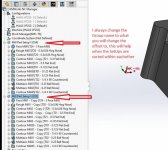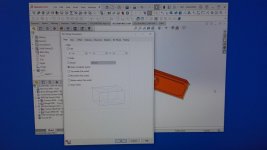Hello,
I am seeking some help with SolidWorks Cam / Camworks. I am trying to figure out the workflow for setting up a simple part at WCS G54 (with all required toolpaths) and then copying / transforming / translating / rotating the setup to allow machining the same part in 3 dual-station vises (6 parts total).
We currently setup the dual-station vises with the “front” location of each of the three vises as “even” (WCS G54, G56, and G58) and we designate the “back” locations as “odd” (WCS G55, G57 and G59). The CAM program for the front (even) WCS are just copies of the G54 part, while the back (odd) WCS are essentially rotated with the signed movements of X & Y flipped.
We currently use HSMWorks to program one setup of the part at G54 and then use the software to "copy" the toolpaths for WCS G56 and G58. This gives us one setup that contains the toolpaths for the 3 “even” WCS.
Next we copy the “even” generated setup, and change the initial WCS to G55 with copies at G57 and G59. This gives us a second setup that contains the toolpaths for the 3 “odd” WCS.
So we end up with two setups and we post-process both to create a program that cuts all six parts in one cycle (one at each WCS - G54 through G59).
The HSMWorks software allows this easily by checking a few boxes in the software.
We would like to move to Solidworks Cam (rebranded Camworks), but I have yet to figure out how to do the setups. I would like to find the workflow that is the best / easiest way to do this, but I have yet to figure it out.
I would think there are plenty of shops using Camworks and dual-station vises to make multiple parts in a cycle. Is anyone out there a Camworks or SolidWorks CAM user that can shed some light on this? Any help is appreciated.
I am seeking some help with SolidWorks Cam / Camworks. I am trying to figure out the workflow for setting up a simple part at WCS G54 (with all required toolpaths) and then copying / transforming / translating / rotating the setup to allow machining the same part in 3 dual-station vises (6 parts total).
We currently setup the dual-station vises with the “front” location of each of the three vises as “even” (WCS G54, G56, and G58) and we designate the “back” locations as “odd” (WCS G55, G57 and G59). The CAM program for the front (even) WCS are just copies of the G54 part, while the back (odd) WCS are essentially rotated with the signed movements of X & Y flipped.
We currently use HSMWorks to program one setup of the part at G54 and then use the software to "copy" the toolpaths for WCS G56 and G58. This gives us one setup that contains the toolpaths for the 3 “even” WCS.
Next we copy the “even” generated setup, and change the initial WCS to G55 with copies at G57 and G59. This gives us a second setup that contains the toolpaths for the 3 “odd” WCS.
So we end up with two setups and we post-process both to create a program that cuts all six parts in one cycle (one at each WCS - G54 through G59).
The HSMWorks software allows this easily by checking a few boxes in the software.
We would like to move to Solidworks Cam (rebranded Camworks), but I have yet to figure out how to do the setups. I would like to find the workflow that is the best / easiest way to do this, but I have yet to figure it out.
I would think there are plenty of shops using Camworks and dual-station vises to make multiple parts in a cycle. Is anyone out there a Camworks or SolidWorks CAM user that can shed some light on this? Any help is appreciated.
















